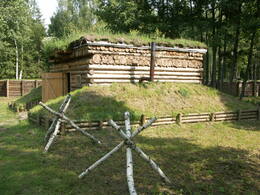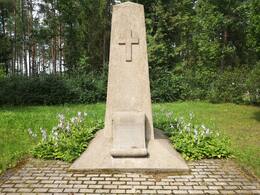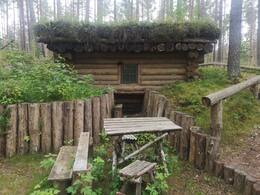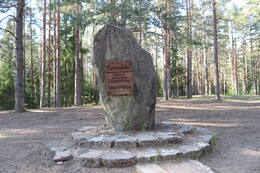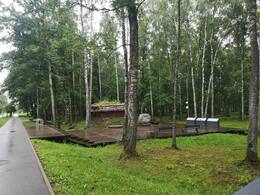Gynybinių pozicijų formavimas.
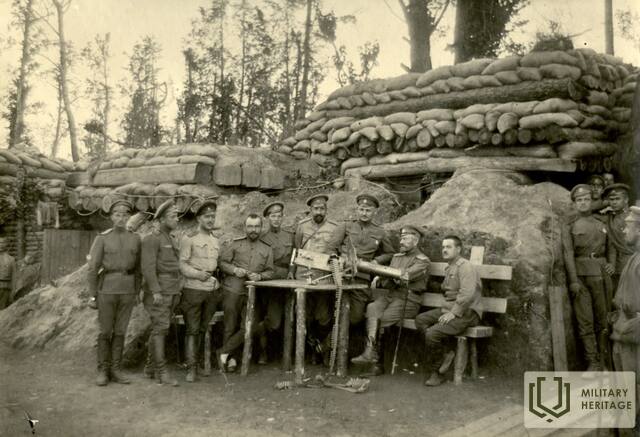
Aprašyme apskritai nagrinėjama mūšio lauko įtvirtinimo problema. Jis sukurtas remiantis I pasaulinio karo patirtimi ir situacija, kai būtina organizuoti didelius įtvirtinimų kūrimo darbus.
"(..) Šių laikų kare karys turi mokėti su kastuvu elgtis taip pat, kaip su šautuvu. Jei kariui pavyko, reikia nedelsiant, nepaisant nuovargio, sutvirtinti kastuvu. Lauko kare kiekviena kariuomenės dalis turi sugebėti pati savo jėgomis statyti apkasus, kodėl būtina gerai išmanyti apkasų organizavimo principą ir griovių gręžimo principus. darbas (..)“.
"(..) Visose užsienio armijose kiekvienas pėstininkų pulkas turi būrius ar kuopas šaulių ar pionierių. Siekiant atskirti pėstininkų sapierius nuo technikos kariuomenės šaulių, kai kuriose šalyse pėstininkų sapieriai vadinami pionieriais, kaip mes juos vadinsime. Pėstininkų pulke pionierių užduotis yra atlikti kai kuriuos proto karininkus, kurie nėra tinkami tam pajėgoms. laukuose, atliekant nesudėtingus sprogdinimo darbus, statant apkasus, stiprinant rūsius, ruošiant kamufliažinius tinklus ir kt. Be to, pionieriai privalo dalyvauti žvalgyboje su pareigomis, pateikti savo įvertinimą ir pristatyti pulko ar bataliono vadui statybos planą ir darbų planą Ginčus visada sprendžia pulko ar bataliono vadas, bataliono, kuriame yra visų pagrindinių šalių, bataliono pajėgos 2-3 sapierių kompanijos ir inžinierių parkas Mažesnėse šalyse, kurios nėra tokios turtingos ir negali nusipirkti daug techninės įrangos, kiekvienas padalinys turi po sapierių kuopą ir inžinierių parką. Sapieriai skirstomi į skirtingas specialybes, pavyzdžiui, bombonešiai, dailidės, minosvaidžiai, pontonininkai, kamufliažieriai ir tt Sapieriai turi remti pėstininkus mūšyje dėl įtvirtintų pozicijų, žvalgybos, kliūčių įveikimo ir šoko. Sapperiai gauna įsakymus iš pėstininkų vadų. Sapieriai sutinka atlikti sudėtingiausias technines užduotis, kurių pėstininkai negali atlikti, pavyzdžiui: kolonų kelių tiesimas sudėtingoje vietovėje, tiltų paruošimas ir aptarnavimas, minų laukų įrengimas, sprogdinimas, minų galerijų gabenimas ir kt., kurias galima įrengti per trumpą laiką ir virš kurių galima uždėti didelius svorius. (..)"
Technikos aprašymas. Nr. 3. 1927 m. Mūšio lauko įtvirtinimas.
Susijusi laiko juosta
Susijusios vietos
Kalėdų mūšių muziejus
Muziejus, įsikūręs sodyboje „Mangaļi“ Jelgavos apylinkėse, Valgundės seniūnijoje, yra Latvijos karo muziejaus filialas. Jis atidarytas 2005 m. toje vietoje, kurioje per Pirmąjį pa saulinį karą vyko Kalėdų mūšiai. Šiose vietose iki šiol tebėra išlikę išskirtiniai Pirmojo pasaulinio karo įtvirtinimai. Kalėdų mūšių muziejaus ekspozicija yra įrengta autentiškoje vieto je po atviru dangumi. Čia galima pamatyti rekonstruotą įtvirtinimų sistemos fragmentą – lauko slėptuvę ir dalį pir mosios vokiečių gynybos linijos, vadinamos „vokiečių pyli mu“. Tai vienintelis tokio pobūdžio objektas Baltijos šalyse. Kalėdų mūšiai – vienas žinomiausių ir dramatiškiausių Pir mojo pasaulinio karo įvykių Latvijoje. Jie užima ypatingą vietą latvių karo ir kultūros istorijoje. Intensyvūs mūšiai truko šešias dienos ir pareikalavo daug aukų. Šie įvykiai dažniau siai siejami su latvių šaulių puolimu prieš Vokietijos kariuo menę, vykusiu ypač atšiauriomis ir nepalankiomis žiemos sąlygomis. Tai buvo pirmas kartas, kai didelio masto puo limas vyko be artilerijos palaikymo. Šiuo metu muziejuje eksponuojami mūšių vietose rasti radi niai. Vidaus ekspozicija lankoma nustatytu laiku, o po atvi ru dangumi esančių įtvirtinimų ekspoziciją galima apžiūrėti kiekvieną dieną. Apylinkėse sudaryti turistiniai maršrutai ir įrengti pažintiniai takai.
Christmas battles memorial at Antinu Brethren Cemetery
Located in Babīte district, on the side of the road near the former Antiņi house and the old medicine warehouse.
The cemetery of Antiņi or Tīreļi soldiers was established during the First World War. The defense positions of the army of the Russian Empire were located in the area. In 1917, during the Christmas battles, the headquarters of the 5th Zemgale Latvian Rifle Regiment and an infirmary with a medicine warehouse were located nearby.
In the night of January 5, 1917, in the light of eight huge bonfires, 105 fighters of the 5th Zemgale Latvian Rifle Regiment were buried in military honor. They fell in battle against the German army or died from injuries. The funeral ceremony was led by Regiment Commander Jukums Vācietis. In later years, soldiers from other units of the Russian army were also buried in the cemetery. In 1925, a monument to the architect Eizen Laube was unveiled in the cemetery, and the territory was landscaped. Information about the 3,800 soldiers buried in the cemetery can be found in many places, but it must be assessed as unlikely and unverified.
Latvian riflemen positions and trenches in Tīreļi
Latvian Riflemen dugouts and trenches in Tīreļi are located in Babīte parish, Mārupe municipality, in the vicinity of the Antiņi Latvian Riflemen Cemetery and the former medicine warehouse. During World War I this was the defensive position of Latvian Riflemen of the Russian Imperial Army. A complex of trenches and surface dugouts was built in the sandy hills. Trench or positional warfare is the best way to accurately describe World War I and emphasise the importance of fortifications. They were based on the research of military engineers and adapted to the environment and the development of new weapons. The everyday life of a soldier is a continuous improvement of defensive fortifications. Sometimes soldiers would give the dugouts names that reminded them of their homes and would help to forget about the reality of the war. Trench lines were complex defensive systems that were hard for the enemy to take. With the development of weapons these defences became even more sophisticated. The roofs of dugouts were reinforced to withstand artillery shells. Trenches were made in changing patterns and directions so that explosions would cause as little damage as possible. Movement passages had pockets that were used as short-term hiding spots during artillery fire, because they protected soldiers from shrapnel and rubble. Today part of the fortification has been restored and you can visit 3 restored dugouts and a 100 m long section of the trenches.
Kulkosvaidžio kalnas Tyrelio pelkėje
Kulkosvaidžio kalnas (Ložmetėjkalnas) yra Jelgavos apy linkėse, Valgundės seniūnijoje, šalia automagistralės A9. Tai Pirmojo pasaulinio karo mūšių vieta ir vienintelis vals tybinės reikšmės kultūrinis ir istorinis draustinis Latvijoje. Ložmetėjkalnas yra ant Ilgosios kopos, priklausančios Nor dekių–Kalnciemo kopagūbriui. Pavadinimas atsirado tais laikais, kai čia buvo įrengti neįveikiami Vokietijos kariuo menės įtvirtinimai, ginami sunkiaisiais kulkosvaidžiais. Kalėdų mūšiai – vienas žinomiausių ir dramatiškiausių Pirmojo pasaulinio karo įvykių Latvijos istorijoje. 1917 m. Ložmetėjkalną puolė ir užėmė Rusijos kariuomenės latvių šaulių bei sibiriečių daliniai. Jie paėmė į nelaisvę apie 600 priešo karių ir užgrobė vertingų trofėjų. Patys šauliai tvirtino, kad būtent jie nusipelnė vadintis šios aukštumos užkariautojais. Kulkosvaidžio kalno (Ložmetėjkalno) apylinkėse yra išlikę atminimo ženklai ir kitų čia vykusių mūšių liudijimai. Kas met sausio mėnesį čia vyksta renginiai, skirti Kalėdų mūšių atminimui. Ši vieta tapo latvių šaulių didvyriškumo ir narsos simboliu. Čia pastatytas 27 m aukščio apžvalgos bokštas, nuo kurio atsiveria Kalėdų mūšių vietos vaizdas.
WWI Historical Exploration Route and dugout
Located in Olaine, near the Olaine Museum of History and Art.
The historical route was established in 2018 at the site of the fortifications of the Russian army during World War I, which were part of the defense system of the area. The fighting between the German and Russian armies in the Olaine area attracts attention for several reasons. The marshy terrain prevented the warring parties from making rapid progress and required a variety of skills from the soldiers to operate in adverse conditions. Accurate terrain analysis, reconnaissance, and fortifications or engineering structures played an important role in the war.
Nowadays, the cognitive route is freely available and gives a rough idea of the living conditions of soldiers. The renovated buildings are closed, but can be seen by contacting the specialists of the Olaine History and Art Museum in advance.
Olaine History and Art Museum
The exhibit in the Olaine History and Art Museum is about the period of Soviet occupation in Olaine. A World War I exploration route with restored elements of the fortifications has been created in the territory of the museum. On the site, where the World War I Russian Army defence line once was, a Russian soldier-type dugout has been built and a fragment of a shooting tower can be viewed by visitors. A World War I reinforced concrete fortification can be seen in Jaunolaine, at the intersection to Plakanciems. During World War I, active battles were fought between the Russian and German armies in this area. Latvian Riflemen units were involved in intelligence and various other operations. Marshy lands made it difficult to defend, but this was a very important area in Latvian military history. Olaine was formed due to the convenient location between Jelgava and Riga, where Jaunolaine is currently located. The Olaine manor was nearby. The modern day Olaine was built during the Soviet occupation, when industrial companies began their operations there.





